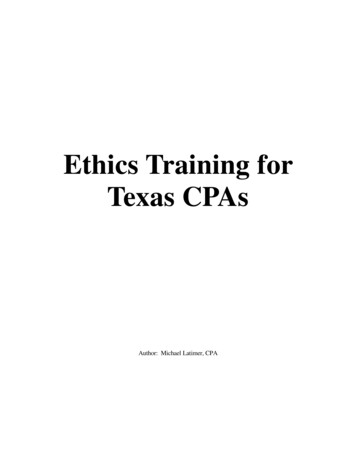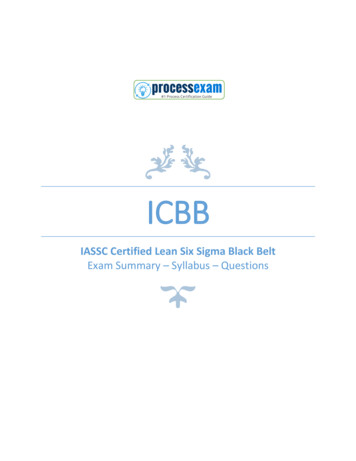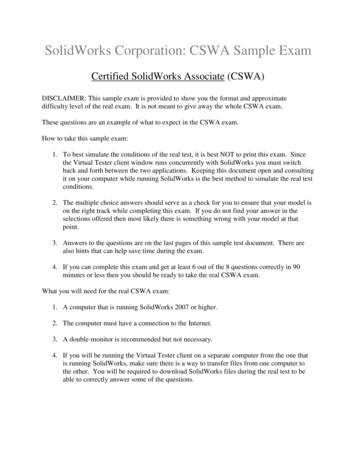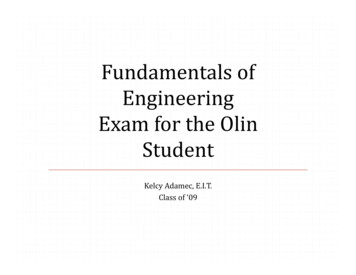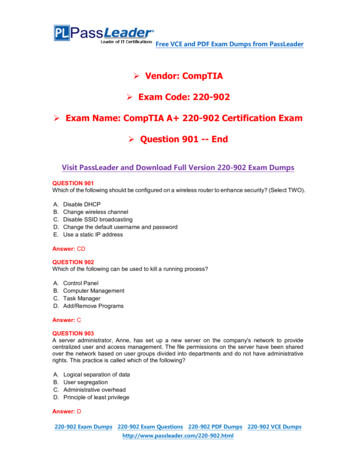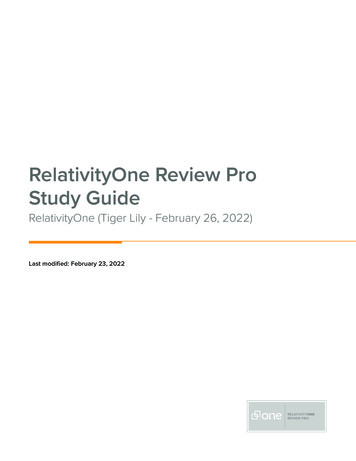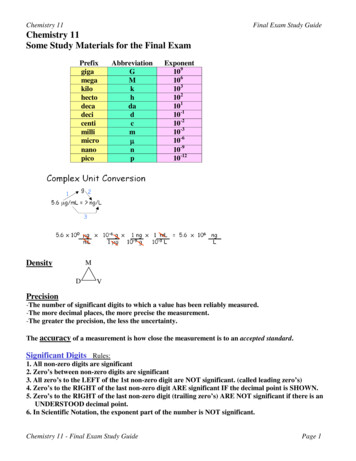
Transcription
Chemistry 11Final Exam Study GuideChemistry 11Some Study Materials for the Final -The number of significant digits to which a value has been reliably measured.-The more decimal places, the more precise the measurement.-The greater the precision, the less the uncertainty.The accuracy of a measurement is how close the measurement is to an accepted standard.Significant Digits Rules:1. All non-zero digits are significant2. Zero’s between non-zero digits are significant3. All zero’s to the LEFT of the 1st non-zero digit are NOT significant. (called leading zero’s)4. Zero’s to the RIGHT of the last non-zero digit ARE significant IF the decimal point is SHOWN.5. Zero’s to the RIGHT of the last non-zero digit (trailing zero’s) ARE NOT significant if there is anUNDERSTOOD decimal point.6. In Scientific Notation, the exponent part of the number is NOT significant.Chemistry 11 - Final Exam Study GuidePage 1
Chemistry 11Final Exam Study GuideFor Multiplication or Division:Answer is rounded to the LOWEST # OF SD’S in the data.For Addition or Subtraction:Answer is rounded to the LOWEST # OF DECIMAL PLACES in the data.Some Terms in Unit 3: Observation, Interpretation, Qualitative, Quantitative, Data, Experiment,Hypothesis, Theory, Laws, Matter, Chemistry, Physical and Chemical Properties, Malleability, Ductility,Lustre, Viscosity and Diffusion. Review the Phases of Matter. Define: Observation, Interpretation,Qualitative, Quantitative, Data, Experiment, Hypothesis, Theory, Laws, Matter, Chemistry, Physical andChemical Properties, Malleability, Ductility, Lustre, Viscosity and Diffusion. Review the Phases of Matter.The Methods of Separation of Mixtures:1. Filtration2. Distillation3. Solvent Extraction4. Recrystallization5. Gravity Separation6. Paper ChromatographyTemperature – Time GraphWarming liquidMelting solidWarming solidCovalent names andFormulasChemistry 11 - Final Exam Study GuidePage 2
Chemistry 11Chemistry 11 - Final Exam Study GuideFinal Exam Study GuidePage 3
Chemistry 11Final Exam Study GuidePercent CompositionChemistry 11 - Final Exam Study GuidePage 4
Chemistry 11Chemistry 11 - Final Exam Study GuideFinal Exam Study GuidePage 5
Chemistry 11Chemistry 11 - Final Exam Study GuideFinal Exam Study GuidePage 6
Chemistry 11Chemistry 11 - Final Exam Study GuideFinal Exam Study GuidePage 7
Chemistry 11Chemistry 11 - Final Exam Study GuideFinal Exam Study GuidePage 8
Chemistry 11Chemistry 11 - Final Exam Study GuideFinal Exam Study GuidePage 9
Chemistry 11Chemistry 11 - Final Exam Study GuideFinal Exam Study GuidePage 10
Chemistry 11Final Exam Study GuideExcess and Limiting Reactant ProblemsChemistry 11 - Final Exam Study GuidePage 11
Chemistry 11Chemistry 11 - Final Exam Study GuideFinal Exam Study GuidePage 12
Chemistry 11Chemistry 11 - Final Exam Study GuideFinal Exam Study GuidePage 13
Chemistry 11Final Exam Study GuideElectron-Dot FormulasElectronegativity – the tendency of an atom to attract electrons from a neighbouring atom.When the electronegativities of two atoms are quite different from each other:One atom loses an electron (or electrons) The other atom gains an electron (or electrons)This results in an Ionic Bond.Crystal LatticeChemistry 11 - Final Exam Study GuidePage 14
Chemistry 11Final Exam Study GuideWhen Electronegativities of bonding atoms are the same (as they are in diatomic molecules) or closeto the same, they SHARE electrons.Bonds formed when atoms share electrons are called Covalent Bonds.In diatomic molecules (like H2 or Cl2), the electronegativities of both atoms are exactly the same soelectrons are shared equally!Bonds within molecules that hold the atoms of a molecule together are called intramolecular bonds.They are strong covalent bonds.Covalent BondsA dipole is a partial separation of charge which exists when one end of a molecule has a slightpositive charge and the other end has a slight negative chargeWhen electrons are shared unequallybetween two atoms, the bond is calledPolar Covalent.Chemistry 11 - Final Exam Study GuidePage 15
Chemistry 11Chemistry 11 - Final Exam Study GuideFinal Exam Study GuidePage 16
Chemistry 11Chemistry 11 - Final Exam Study GuideFinal Exam Study GuidePage 17
Chemistry 11An enthalpy diagram for an exothermic reaction:Final Exam Study GuideEnthalpy (H) 2C8H18 25O2 H isNegative16CO2 18H2OReaction ProceedsSo, to summarize, in an exothermic reaction: H is negative Products are lower than Reactants on the Enthalpy DiagramHeat is released to the surroundingsIn an endothermic reaction: Heat is absorbed from the surroundings and converted into enthalpy.Here is an enthalpy graph for an endothermic reaction:Enthalpy (H)H2O CO2 NaCl H isPositiveNaHCO3 HClReaction ProceedsHeat and Moles in EquationsFind the amount of heat released during the formation of 14.6 moles of NH3, given the reaction:N2 3H2 2NH3 46.2 kJSolution:46.2kJ14.6 mol NH3 x 337 kJ2molNH 3Calorimetry:Example: Given that the heat capacity of water: C H 2O 4180 J/kg . oCCalculate the heat required to warm 400.0 g of water from 20 oC to 50 oC.Solution:First we have to change 400.0 g to 0.4000 kg and calculate the temperature change ( t)50 oC - 20 oC 30 oCNext, we write the equation:Heat m . C . tThen we plug in the data:Heat (J) 0.4000 kg x 4180 J/kg . oC x 30 oC 50 160 JChemistry 11 - Final Exam Study GuidePage 18
Chemistry 11 - Final Exam Study Guide Page 15 When Electronegativities of bonding atoms are the same (as they are in diatomic molecules) or close to the same, they SHARE electrons. Bonds formed when atoms share electrons are called Covalent Bonds . In diatomic molecules (like H 2 or Cl 2), the electronegativities of both atoms are exactly the .




